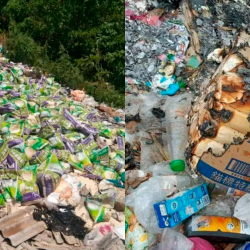FACTBOX-What are the micro-organisms causing elephant deaths in Botswana?
(Adds codes for additional clients, no change to text)
JOHANNESBURG, Sept 21 (Reuters) - Botswana wildlife officials said on Monday that toxins produced by microscopic organisms called cyanobacteria had caused the deaths of 330 elephants this year.
Since they were first reported around early May, the elephant deaths had baffled and alarmed conservationists, who feared they could escalate.
Below are some facts about cyanobacteria.
WHAT ARE THEY?
Cyanobacteria are micro-organisms that are common in water and also occur in soil. Some can produce toxins that damage the liver or nervous system of animals and humans.
Sometimes called blue-green algae, they have algae-like characteristics such as using sunlight to make food.
HOW DO THEY SPREAD?
Cyanobacteria proliferate in warm, nutrient-rich conditions.
When they multiply they can create blooms that spread across the surface of a water body and discolour it.
Fertilisers used by farmers can encourage cyanobacterial blooms to form through nutrient loading.
HOW IS CLIMATE CHANGE INVOLVED?
Many cyanobacteria favour warmer water temperatures, which scientists say are occurring more frequently because of climate change.
Southern Africa's temperatures are rising at twice the global average, making the region especially vulnerable.
WHAT CAN BE DONE?
Once cyanobacterial blooms form, there is no simple solution to get rid of them, according Luyanda Ndlela, a researcher at South Africa's national science council.
Scientists like Ndlela are trying to identify substances that can break down cyanotoxins or control the cyanobacteria themselves without disrupting the ecosystem.
Experts are also trying to develop models to predict when cyanobacterial blooms might occur.
IS THIS ONLY HAPPENING IN AFRICA?
No. Cyanobacteria and the toxins they produce can occur around the world.
Scientists have linked cyanotoxins to more than 100 people falling ill near Lake Erie in the United States in 2014, and to a 1996 episode in Brazil's Pernambuco state where patients at a dialysis centre died from liver failure.
"It amounts to having the right conditions, in the right time, in the right place and these species will proliferate," said Patricia Glibert, a professor at the University of Maryland Center for Environmental Science. (Reporting by Alexander Winning; Editing by Mike Collett-White)






